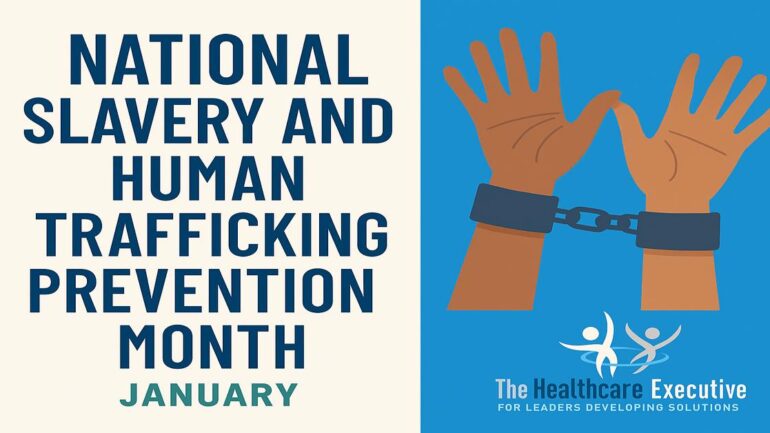National Slavery and Human Trafficking Prevention Month 2025: A Healthcare Leadership Imperative

- Posted by Greg Wahlstrom, MBA, HCM
- Posted in Health Observance Calendar
Why Health Systems Must Lead in Trauma-Informed Prevention and Survivor-Centered Care
Published: January 8, 2025
January marks National Slavery and Human Trafficking Prevention Month—a time for healthcare leaders to confront a pervasive, often hidden crisis. Human trafficking affects an estimated 27.6 million people worldwide, many of whom interact with healthcare systems during their exploitation. Hospitals are uniquely positioned to identify and support victims, yet many lack the protocols and training to do so effectively. For executives, this month is a call to action: to embed trauma-informed practices, enhance staff training, and forge community partnerships that prioritize survivor care.
Healthcare providers often encounter trafficking victims without realizing it. According to the U.S. Department of Health and Human Services, up to 88% of trafficking survivors reported seeking medical care during their exploitation. This underscores the essential role of healthcare settings in identifying and assisting victims. Implementing standardized screening tools and training staff to recognize signs of trafficking can make a significant difference. Resources like the 2025 Human Trafficking Prevention Month Toolkit offer valuable guidance for healthcare institutions aiming to enhance their response protocols.
Trauma-informed care is essential in addressing the needs of trafficking survivors. This approach recognizes the widespread impact of trauma and integrates this understanding into all aspects of patient care. By fostering an environment of safety, trust, and empowerment, healthcare providers can better support survivors’ recovery and reduce the risk of re-traumatization. Training programs and organizational policies should reflect these principles to ensure a compassionate and effective response.
Leadership commitment is vital in driving systemic change. Executives must prioritize the development and implementation of comprehensive anti-trafficking policies, allocate resources for staff training, and establish clear protocols for victim identification and referral. Collaborating with local organizations and law enforcement can also enhance the effectiveness of these initiatives. By taking a proactive stance, healthcare leaders can position their institutions as safe havens for victims seeking help.
Community engagement is significant within prevention efforts. Healthcare systems can lead public awareness campaigns, participate in local coalitions, and support educational programs that inform the public about the signs of trafficking and available resources. Engaging with survivors and incorporating their insights can further strengthen these initiatives, ensuring they are grounded in real-world experiences and needs.
Data collection and analysis are crucial for measuring the impact of anti-trafficking efforts. Healthcare institutions should track the number of identified victims, referrals made, and outcomes achieved to assess the effectiveness of their programs. This information can guide continuous improvement and demonstrate the organization’s commitment to addressing human trafficking.
Technology can also aid in combating trafficking. Electronic health records (EHRs) can be configured to include prompts for screening questions and alerts for potential red flags. Telehealth services offer additional avenues for reaching at-risk populations, especially in underserved areas. Investing in these technological solutions can enhance the healthcare system’s capacity to identify and support victims.
Workforce well-being is another critical consideration. Staff involved in anti-trafficking efforts may experience secondary traumatic stress. Providing support services, such as counseling and peer support groups, can help maintain staff resilience and ensure the sustainability of these programs.
Policy advocacy is an avenue through which healthcare leaders can effect broader change. Supporting legislation that strengthens protections for trafficking victims and increases funding for related programs can amplify the impact of institutional efforts. Engaging in policy discussions and sharing insights from the healthcare perspective can inform more effective and comprehensive solutions.
As we observe National Slavery and Human Trafficking Prevention Month, healthcare leaders have an opportunity to reaffirm their commitment to combating this human rights violation. By integrating trauma-informed care, fostering community partnerships, leveraging technology, and advocating for policy change, healthcare systems can play a pivotal role in ending human trafficking and supporting survivors on their path to recovery.
Explore how your leadership team can build better clinician support models, patient-centered care pathways, and whole-person health strategies that begin with trauma-informed care and survivor support. Our latest analysis offers a roadmap for executives leading transformative change.
Discover More
If your organization is looking to support clinicians and patients through improved safety, trust, and chronic condition prevention, explore our post on trauma-informed leadership strategies for 2025.



